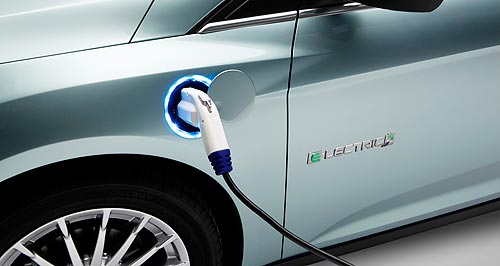Make / Model Search
News - General News - Electric VehiclesCar-makers collaborate on EV charging standardMore than a plug: An EV fast-charging standard must take into account both a connector compatibility and a common protocol for EVs to communicate with the charging post. Seven vehicle manufacturers team up to define single standard for EV fast-charging14 Oct 2011 THE automotive industry is starting to collaborate on setting a standard for the fast charging of electric vehicles to aid the rollout of infrastructure and make owning an EV easier for consumers. Meanwhile, Nissan in conjunction with Kansai University in Japan, has reportedly developed a new technology that promises to dramatically speed up EV recharging, claimed to require just 10 minutes for a full charge thanks to improvements in capacitor technology. Manufacturers signed up to the harmonised fast-charging standard – which so far is only applicable to Europe and the US – include BMW, Daimler, Ford, General Motors and Volkswagen, including VW group constituents Audi and Porsche. The result will be that all future EVs from the collaborating manufacturers will be able to use the same type of fast charger, as well as products from other brands that subsequently adopt the standard.  In addition to the infrastructure and consumer advantages, manufacturers will benefit from a reduction in complexity when designing and building vehicles, plus the associated economies of scale. In addition to the infrastructure and consumer advantages, manufacturers will benefit from a reduction in complexity when designing and building vehicles, plus the associated economies of scale.The proposed system must not only feature a standardised charging connector but integrate all possible charging scenarios, much like the Universal Serial Bus (USB) standard introduced for computers and other electronic devices in the mid-1990s. Manufacturers using existing Level 1 and Level 2 connectors agree that standardisation increases the take-up of EVs by the public. As such, the new system will be backwards-compatible with the commonly-used J1772 connector standard in the U.S and the European IEC 62196 Type 2 standard, meaning consumers will be able to continue using existing Level 2 charging stations. In addition, the standard must include a common way for vehicles to communicate with the charger and for this, the seven collaborating manufacturers have agreed to adopt the HomePlug Green PHY (HPGP) standard. HPGP enables vehicles to integrate with ‘smart grid’ systems that can provide facilities like remote charge monitoring and control plus the management of grid load and demand for the energy supplier. Ford vice president of international government affairs Steve Biegun said the company understands the importance of providing “technologically innovative solutions that are convenient for our customers”. “It's part of our 'One Ford' vision and a key factor in our company's overall success,” he said. “We applied the same philosophy in working with other global automakers and governments to offer one common approach on charging electric vehicles – helping speed infrastructure development, strengthen economic growth and most importantly, make charging even more convenient for our customers. “We especially appreciate the foresight of the Transatlantic Business Dialogue (TABD) and the leadership provided by the Transatlantic Economic Council (TEC), in prioritizing this project and fast-tracking the interactions among automakers, associations and governments that were instrumental in delivering a universal charging system.” Rather than any significant change to the method of drawing charge from an energy source and transferring it to an on-board EV battery, Nissan’s development involves a switch from battery technology to capacitor technology. Internet reports describe a capacitor that replaces carbon in its electrode with tungsten oxide and vanadium oxide, enabling it to hold more power. Under testing, the capacitor could reportedly be fully charged in just 10 minutes while offering almost the same energy storage capacity and voltage as a lithium-ion battery. However it is expected to take 10 years for the technology to become commercially viable, by which time it should help manufacturers reduce EV production costs while making them far more appealing to consumers. Capacitors are already used in micro-hybrid applications such as PSA Peugeot Citroen’s e-HDI system, which uses regenerative braking to first store charge in a capacitor before being fed into the conventional 12-volt battery or used to provide a quick burst of energy to restart the engine after idle-stop has activated. Nissan has also spearheaded a joint-venture with European utility and electrical supply equipment companies Circutor, DBT, Efacec, Endesa and Siemens that is hoped to aid the proliferation of public quick-charge points on the continent through a halving of equipment costs. In the US the company has recently reduced the price of the home charging system for customers of its Leaf EV.  Read more21st of September 2011  Nissan joint-venture to reduce EV quick charger costEuropean Nissan deal to proliferate compact, low-cost ‘30 minute’ EV quick chargers27th of July 2011  Better Place expands EV charging networkNine more organisations sign up for EV charging points in Canberra12th of July 2011  NRMA to the rescue for EVsAustralia’s first mobile electric vehicle charger rolls into action in Sydney4th of February 2011  Sydney next to flick fast-charge switchNRMA to join Mitsubishi with fast charging points for electric vehicles |
Click to shareGeneral News articlesResearch General News Motor industry news |











Facebook Twitter Instagram